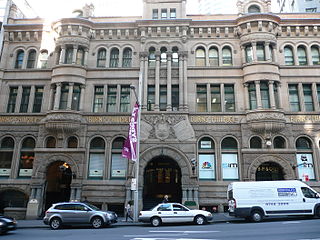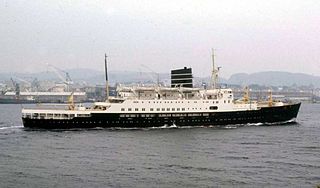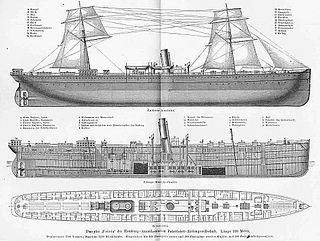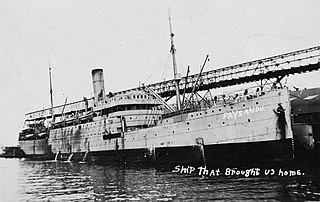Related Research Articles

An ocean liner is a type of passenger ship primarily used for transportation across seas or oceans. Ocean liners may also carry cargo or mail, and may sometimes be used for other purposes. The Queen Mary 2 is the only ocean liner still in service to this day.
Holland America Line (HAL) is a US-owned cruise line, a subsidiary of Carnival Corporation & plc headquartered in Seattle, Washington, United States.

The Hamburg-Amerikanische Packetfahrt-Actien-Gesellschaft (HAPAG), known in English as the Hamburg America Line, was a transatlantic shipping enterprise established in Hamburg, in 1847. Among those involved in its development were prominent citizens such as Albert Ballin, Adolph Godeffroy, Ferdinand Laeisz, Carl Woermann, August Bolten, and others, and its main financial backers were Berenberg Bank and H. J. Merck & Co. It soon developed into the largest German, and at times the world's largest, shipping company, serving the market created by German immigration to the United States and later, immigration from Eastern Europe. On 1 September 1970, after 123 years of independent existence, HAPAG merged with the Bremen-based North German Lloyd to form Hapag-Lloyd AG.

Burns Philp was a major Australian shipping line and merchant that operated in the South Pacific. When the well-populated islands around New Guinea were targeted for blackbirding in the 1880s, a new rush for labour from these islands began. James Burns and Robert Philp purchased several well-known blackbirding ships to quickly exploit the human resource in this region, and Burns Philp entered the slave trade. The company ended its involvement in blackbirding in 1886. In later years the company was a major player in the food manufacturing business. Since its delisting from the Australian Securities Exchange in December 2006 and the subsequent sale of its assets, the company has mainly become a cashed up shell company. It is wholly owned by Graeme Hart's Rank Group.
A number of ships have been named Persia including

SS Abessinia was a cargo steamship of the Hamburg America Line (HAPAG). She was built in North East England in 1900, and wrecked in North East England in 1921. In her early years she sailed from Hamburg to and from China, Australia, and the East Coast of the United States. From 1907 to 1912 she sailed from Hamburg to and from the West Coast of the United States and the British Columbia Coast. In 1913 she survived a storm in the North Atlantic that swept away her rudder and disabled her propulsion. She spent the First World War in Chile. Her remains are now a wreck diving site in the Farne Islands.

Rapido was an auxiliary cruiser that served in the Spanish Navy during the Spanish–American War in 1898. Before her Spanish Navy service, she served as the commercial passenger ship SS Columbia for the Hamburg America Line from 1889 to 1898. She returned to commercial service as Columbia with Hamburg America from 1899 to 1904, but early in 1904 the Imperial Russian Navy purchased her for service as the auxiliary cruiser Terek during the Russo-Japanese War of 1904–1905.

SS Ypiranga was a cargo liner that was launched in Germany in 1908 for the Hamburg America Line (HAPAG). In 1919 the United Kingdom seized her for World War I reparations. In 1921 Anchor Line acquired her and renamed her Assyria. In 1929 the Companhia Colonial de Navegação (CCN) bought her and renamed her Colonial. In 1950 she was sold for scrap, but she sank off the coast of Scotland while being towed to a scrapyard.

The Bergen Steamship Company (BDS), was founded in 1851 by Michael Krohn to operate a shipping service between the Norwegian ports of Bergen, Stavanger, and Kristiansand and the German port of Hamburg with the paddle steamer Bergen. The company funnel was black with three widely spaced narrow white bands.
A number of steamships have carried the name Vega, including

The SS Silesia was a late 19th-century Hamburg America Line passenger and cargo ship that ran between the European ports of Hamburg, Germany and Le Havre, France to Castle Garden and later Ellis Island, New York transporting European immigrants, primarily Russian, Prussian, Hungarian, German, Austrian, Italian, and Danish individuals and families. Most passengers on this route were manual laborers, including stonecutters, locksmiths, farmers, millers, upholsterers, confectioners, and tailors, though physicians and other professionals also bought passage on her.
Several steamships have borne the name Donau, after the German name for the river Danube:
Several steamships have borne the name Sirius:
Several steamships have borne the name Stella:
Five steamships have borne the name Bosnia, after Bosnia:

SS Burdigala was an ocean liner that sailed the Atlantic Ocean from 1898 until World War I. The ship was built as the Kaiser Friedrich in 1898 for Norddeutscher Lloyd (NDL), a German shipping line. Designed to break the speed record for a transatlantic liner and thereby win the Blue Riband, the Kaiser Friedrich never achieved the necessary speeds. After a short career with NDL and an equally short period of service with NDL's main German competitor, the Hamburg-Amerikanische Packetfahrt-Aktien-Gesellschaft, the ship was mothballed for a decade. After being sold to the French shipping line Compagnie de Navigation Sud-Atlantique, it re-entered service as SS Burdigala. In 1916, while en route from Thessaloniki to Toulon, the liner struck a mine laid by the German U-boat U-73 in the Aegean Sea and sank near Kea, Greece.

USS Eten (ID-4041) was a troop transport commissioned in 1919 to assist in the post-World War I repatriation of U.S. troops from France.

USS Paysandu (ID-3880) was a troop transport acquired to repatriate U.S. troops from France after World War I.

SS Bulgaria was a passenger-cargo steamship built in 1898 for the Hamburg American Line ("Hapag"). During World War I, she operated as a United States Army animal and cargo ship under the names USAT Hercules and USAT Philippines, and after the war was converted into the troop transport USS Philippines (ID-1677).

A. H. Bull Steamship Company was a shipping company and passenger liner service founded in New York City in 1902 by Archibald H. Bull (1848-1920). Service started with shipping between New York and Florida. His fleet of ships then added service to other Eastcoast ports. The company is also often called the Bull Lines and the Bull Steamship Line or A. H. Bull & Company. While founded in New York, Bull soon move its headquarter to Peir 5 in Baltimore, Maryland. Bull Lines main Eastcoast ports were: Baltimore, Charleston, Philadelphia, Tampa and Norfolk, Virginia. Oversea ports: Porto Rico, Antwerp, Bordeaux, Hamburg, Bremen, Copenhagen, and West Africa. Bull Steamship Line supported the US war effort for both World War I and World War II, including the loss of ships.
References
- ↑ "Silesia (5601047)" . Miramar Ship Index . Retrieved 2021-12-27.
- ↑ "Shipping Intelligence". The Standard. No. 27, 502. London. 3 August 1912. p. 3. Retrieved 27 December 2021– via British Newspaper Archive.
- ↑ "F 1609/10/20 Seizure at Trieste of Austrian ship condemned in Shanghai Prize Court" (PDF). Confidential British Foreign Office Correspondence. Foreign and Commonwealth Office. p. 38. Archived from the original (PDF) on 2016-03-04.
- ↑ "SS Silesia (+1939)". WreckSite. Retrieved 28 June 2011.